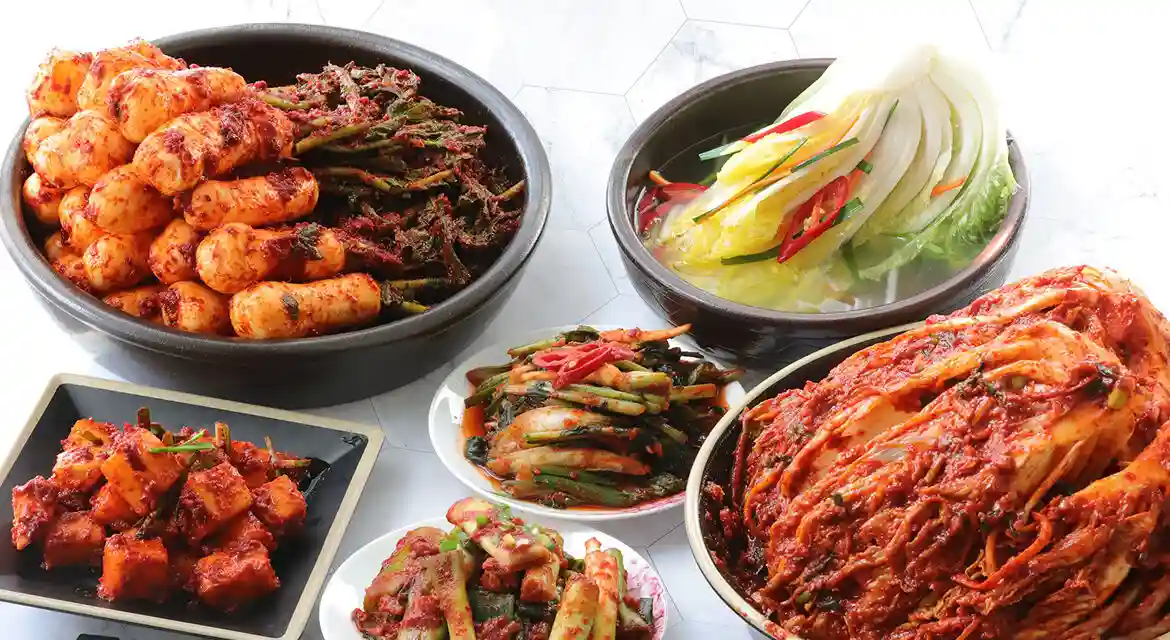Kimche: The Heart of Korean Cuisine
Kimche, a cornerstone of Korean cuisine, has gained worldwide recognition for its unique flavor profile and health benefits. This fermented vegetable dish has been an integral part of Korean culture for centuries, evolving from a simple preservation method to a beloved staple found in households and restaurants across the globe. In this comprehensive guide, we’ll explore the rich history, diverse varieties, and nutritional benefits of kimche, as well as its preparation methods and cultural significance.
What is Kimche?
Kimche, sometimes spelled as kimchi or gimchi, is a traditional Korean side dish made from fermented vegetables. While the most common variety features napa cabbage, there are numerous variations using different vegetables and seasonings. The fermentation process gives kimche its distinctive tangy flavor and probiotic properties, making it both a delicious and nutritious addition to any meal.
Key characteristics of kimche:
- Fermented vegetable dish
- Tangy, spicy, and umami flavors
- Rich in probiotics and nutrients
- Versatile ingredient in Korean cuisine
- Long shelf life due to fermentation
The History of Kimche
Ancient Origins
The history of kimche dates back over 2,000 years, with its roots in the ancient Korean kingdom of Goguryeo. Initially, kimche was a simple method of preserving vegetables for the long, harsh winters when fresh produce was scarce. The earliest forms of kimche were likely made by salting vegetables and storing them in earthenware pots buried underground.
Evolution Through the Ages
As trade routes expanded and new ingredients were introduced to the Korean peninsula, kimche recipes began to evolve. The introduction of chili peppers from the Americas in the 16th century dramatically changed the flavor profile of kimche, giving it the spicy kick that is now synonymous with many varieties.
Modern Significance
Today, kimche is not just a food but a cultural icon in Korea. It has been recognized by UNESCO as an Intangible Cultural Heritage of Humanity, highlighting its importance in Korean cuisine and society. The dish has also gained international popularity, with kimche-inspired products appearing on menus and in grocery stores worldwide.
Types of Kimche
While napa cabbage kimche (baechu kimche) is the most well-known variety, there are hundreds of different types of kimche, each with its unique flavors and textures. Here are some popular variations:
- Baechu Kimche: Made with napa cabbage, this is the most common type.
- Kkakdugi: Cubed radish kimche with a crunchy texture.
- Chonggak Kimche: Whole young radish kimche, including the greens.
- Oi Sobagi: Stuffed cucumber kimche, often filled with other vegetables and seasonings.
- Gat Kimche: Made with mustard leaves, offering a slightly bitter flavor.
- Baek Kimche: A white, non-spicy variety made without chili powder.
- Nabak Kimche: A watery, refreshing kimche often served as a cold soup.
Health Benefits of Kimche
Kimche is not only delicious but also packed with nutrients and health-promoting compounds. Its fermentation process creates beneficial probiotics, which contribute to many of its health benefits.
Nutritional Profile
Kimche is low in calories but rich in:
- Vitamins A, B, and C
- Fiber
- Iron
- Calcium
- Antioxidants
Health Advantages
Regular consumption of kimche has been associated with several health benefits:
- Improved Digestive Health: The probiotics in kimche support gut health and may alleviate digestive issues.
- Boosted Immune System: The fermentation process enhances the bioavailability of nutrients, supporting overall immune function.
- Potential Anti-Inflammatory Effects: Compounds in kimche may help reduce inflammation in the body.
- Weight Management: Low in calories and high in fiber, kimche can be a helpful addition to a balanced diet for weight control.
- Heart Health: Some studies suggest that kimche consumption may be associated with lower cholesterol levels.
Making Kimche at Home
Creating your own kimche at home can be a rewarding experience. While the process requires patience, the result is a flavorful, probiotic-rich dish that can be customized to your taste preferences.
Basic Ingredients for Traditional Kimche
- Napa cabbage
- Korean radish
- Green onions
- Garlic
- Ginger
- Korean red pepper flakes (gochugaru)
- Fish sauce
- Salt
Step-by-Step Process
- Preparation: Clean and chop the vegetables.
- Salting: Salt the cabbage to draw out excess water and begin the fermentation process.
- Rinsing and Draining: After a few hours, rinse the salted cabbage and drain thoroughly.
- Making the Paste: Create a spicy paste with garlic, ginger, fish sauce, and gochugaru.
- Mixing: Combine the paste with the cabbage and other vegetables.
- Fermentation: Pack the mixture into jars and let it ferment at room temperature for several days.
- Storage: Once fermented to your liking, store the kimche in the refrigerator.
Kimche in Korean Cuisine
Kimche is more than just a side dish in Korean cuisine; it’s a versatile ingredient used in countless recipes. Its tangy, spicy flavor adds depth to many dishes, both traditional and modern.
Popular Dishes Featuring Kimche
- Kimche Jjigae: A hearty stew made with kimche, pork, and tofu.
- Kimche Fried Rice: A quick and flavorful dish using leftover rice and kimche.
- Kimche Pancakes: Savory pancakes made with kimche and other vegetables.
- Kimche Dumplings: Traditional dumplings filled with kimche and other ingredients.
- Kimche Grilled Cheese: A fusion dish combining Korean and Western flavors.
Cultural Significance of Kimche
Kimche holds a special place in Korean culture, extending far beyond its role as a food item. It represents Korean identity, history, and tradition.
Kimjang: The Tradition of Kimche Making
Kimjang is the annual tradition of making large quantities of kimche to last through the winter. This communal activity brings together families and communities, strengthening social bonds and passing down cultural knowledge through generations. UNESCO has recognized kimjang as an Intangible Cultural Heritage of Humanity, highlighting its importance in Korean society.
Kimche in Modern Korean Society
Today, kimche continues to be a staple in Korean households, with many families owning dedicated kimche refrigerators. It’s served at almost every meal and is considered an essential part of a balanced diet. The dish has also become a source of national pride, with Korea actively promoting kimche as a global superfood.
Global Popularity and Adaptations
As Korean cuisine gains popularity worldwide, kimche has found its way into international kitchens and restaurant menus. This global recognition has led to interesting adaptations and fusion dishes.
International Variations
- Kimche Tacos: A popular fusion dish in the United States.
- Kimche Pizza: Found in Korea and other countries, combining Italian and Korean flavors.
- Kimche Burgers: Adding a spicy, tangy kick to a classic fast food item.
- Kimche Poutine: A Canadian-Korean fusion dish.
Kimche-Inspired Products
The popularity of kimche has inspired a range of products, including:
- Kimche-flavored snacks
- Kimche seasoning powders
- Ready-to-eat kimche in convenience stores
- Kimche-flavored instant noodles
Storing and Preserving Kimche
Proper storage is crucial to maintaining the flavor and quality of kimche. Here are some tips for storing and preserving your kimche:
- Use Airtight Containers: Store kimche in glass or ceramic containers with tight-fitting lids to contain the strong odors.
- Refrigeration: Once fermented to your liking, keep kimche refrigerated to slow down the fermentation process.
- Kimche Refrigerators: In Korea, many households use specialized kimche refrigerators that maintain optimal temperature and humidity levels.
- Freezing: Kimche can be frozen for long-term storage, though this may affect its texture.
- Submerge in Brine: Ensure the vegetables are fully submerged in the brine to prevent mold growth.
Conclusion
Kimche, a cornerstone of Korean cuisine, has evolved from a simple preservation method to a global superfood. Its rich flavors and health benefits have made it a favorite worldwide, bridging cultural gaps and enhancing culinary experiences. With its historical roots and nutritional value, kimche continues to captivate and inspire, making it a dish to explore and enjoy.







